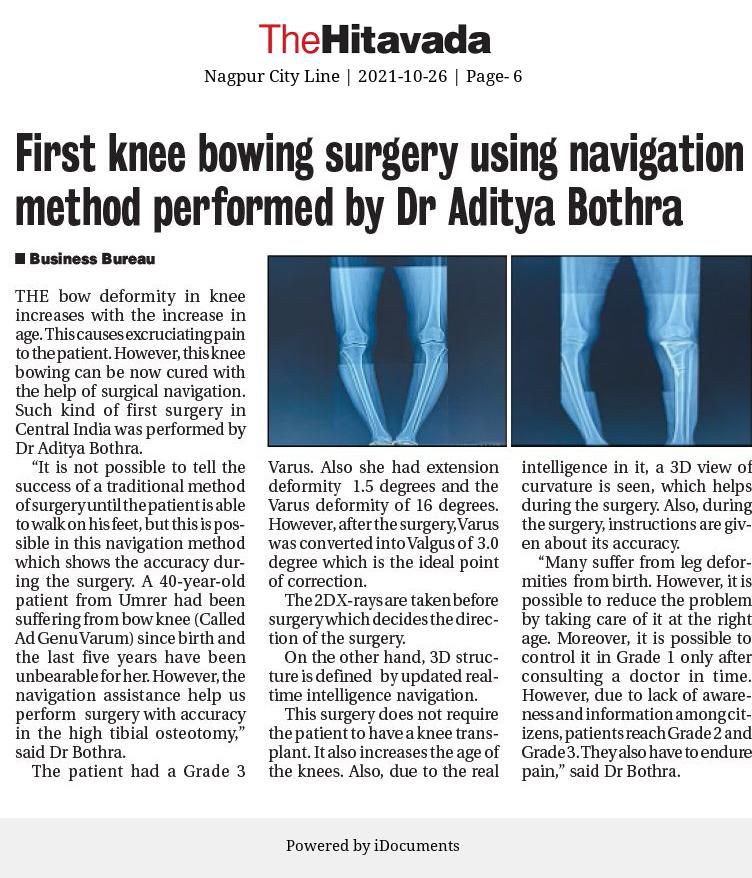


Previous
Next
Dr. Aditya Bothra
Orthopaedic Knee & HIP Replacement Surgeon
Dr. Aditya Bothra
EDUCATION QUALIFICATION
- MBBS
- MS (ORTHOPAEDIC)- GMC RAIPUR AND DR BRAMH HOSPITAL AND LEVEL 1 TRAUMA CENTER
- DNB – PGI CHANDIGARH
CONSULTANT
- CIIMS HOSPITAL, NAGPUR
- SEVEN STAR HOSPITAL NAGPUR
- JOINTS AVENUE NAGPUR
FELLOWSHIPS
- COMPLEX TRAUMA SURGERY WITH DR R M CHANDAK NAGPUR
- NAVIGATION BASED JOINT REPLACEMENT SURGERY – DR C J THAKKAR
- PELVI ACETABULAR RECONSTRUCTION – DR C J THAKKAR
- SPORTS INJURY TREATMENT
Best Orthodepic Doctor in Nagpur
Center of Excellence
Dr. Aditya Bothra Specialities

Hip Replacement
This is a surgical procedure that involves replacing the joint surfaces of the hip. The replacement of the femoral…
Knee Replacement
This is a surgical procedure which replace the weight-bearing surfaces of the knee joint to relieve pain…
Knee Arthroscopy
Knee arthroscopy is a surgical technique that can diagnose and treat problems in the kneejoint…
Knee Fracture
A patellar fracture is a break in the patella, or kneecap, the small bone that sits at the front of your knee…
Know More

Knee Joint Preservation
It refers to the use of nonsurgical or surgical means to preserve a deteriorating joint in order to delay…
Know More

Navigation Based Joint Replacement Surgeries
You may need to undergo knee surgery for a number of reasons…
Know More
News & Media






Previous
Next
View All News
Kick 3
What is kick 3?
Kick 3 is a dynamic navigation which gives us real time assessment of the knee deformity and knee ligament balance
How does it work?
- It works on the principle of 3 point spatial orientation
- We usually keep some trackers on the femur and tibia
- And keep on defining anatomical landmarks as per patient’s anatomy
- Based on this information it gathers a data and give us the actual deformity assessment
View More
0
+
Years of Experience
0
+
Sucessfull Surgeries
0
+
Happy Families
0
+
National and International Awards
Knee replacement surgery (arthroplasty) is a common operation that involves replacing a damaged, worn or diseased knee with an artificial joint.
Adults of any age can be considered for a knee replacement, although most are carried out on people between the ages of 60 and 80.
A smaller operation called a partial knee replacement tends to be performed on younger people aged between 55 and 64 where the artificial joint is expected to need redoing within 10 years.
When a knee replacement is needed
Knee replacement surgery is usually necessary when the knee joint is worn or damaged so that your mobility is reduced and you are in pain even while resting.
The most common reason for knee replacement surgery is osteoarthritis. Other health conditions that cause knee damage include:
- rheumatoid arthritis
- haemophilia
- gout
- disorders that cause unusual bone growth
- death of bone in the knee joint following blood supply problems
- knee injury
- knee deformity with pain and loss of cartilage
Who is offered knee replacement surgery
A knee replacement is major surgery, so is normally only recommended if other treatments, such as physiotherapy or steroid injections, have not reduced pain or improved mobility.
You may be offered knee replacement surgery if:
- you have severe pain, swelling and stiffness in your knee joint and your mobility is reduced
- your knee pain is so severe that it interferes with your quality of life and sleep
- everyday tasks, such as shopping or getting out of the bath, are difficult or impossible
- you’re feeling depressed because of the pain and lack of mobility
- you cannot work or have a social life
You’ll also need to be well enough to cope with both a major operation and the rehabilitation afterwards.
Types of knee replacement surgery
There are 2 main types of surgery:
- total knee replacement – both sides of your knee joint are replaced
- partial (half) knee replacement – only 1 side of your joint is replaced in a smaller operation with a shorter hospital stay and recovery period
Other surgery options
There are other types of surgery which are an alternative to knee replacement, but results are often not as good in the long term. Dr. Aditya Bothra will discuss the best treatment option with you. Other types of surgery may include:
- arthroscopic washout and debridement – a tiny telescope (arthroscope) is inserted into the knee, which is then washed out with saline to clear any bits of bone or cartilage
- osteotomy – the surgeon cuts the shin bone and realigns it so that your weight is no longer carried by the damaged part of the knee
- mosaicplasty – a keyhole operation that involves transferring plugs of hard cartilage, together with some underlying bone from another part of your knee, to repair the damaged surface
Video Gallery
[Rich_Web_Video id=”1″]
Patient Say About Us
Testimonials
[trustindex no-registration=google]
View All Testimonials



